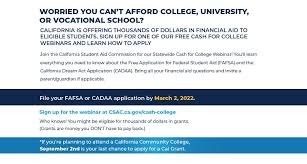
The federal SEOG provides financial aid grants to students who have the greatest need. All applicants must show financial need, and demonstrate a willingness to study in a certain field. These guidelines are quite simple. Here's an overview of how to apply, the eligibility requirements, and any limitations. Before you apply, make sure to read the whole article. Once you have read the entire article, you will be closer to getting your first grant.
Application process
A scholarship called an SEOG grant can be used to help students pay college expenses. A variety of grant programs have been approved by the federal government for students, regardless of whether they are U.S. citizens or citizens from other countries. A Social Security number is required in order to be eligible for a grant. If you are male, you should also be registered with Selective Service. You must also be enrolled in an accredited university full-time or half-time and have a valid GED certificate. You can apply for the SEOG program if you are a student at an accredited college.
FSEOG Opportunity Grants are awarded on the basis of individual financial need and can provide additional $100-$4,000 per year of study. You should check the guidelines to ensure that you are aware of the possible award amounts. Additionally, you must report changes in your financial situation to the school to be eligible for a higher award amount. If your parent's income is higher, your FAFSA should reflect that change.

Eligibility requirements
Federal Student Aid Office, (FSEOG), has specific requirements for FSEOG. First, you must be a U.S. citizen and have a Bachelor's or higher degree. Additionally, you must have a minimum GPA of 2.0. If you are a student who has defaulted on any of their student loans, you will not be eligible for the FSEOG. If you have been awarded a Pell Grant, however, you might be eligible.
The eligibility requirements for FSEOG grants are strict, just like any grant. Individuals who have defaulted in repayment of federal or guaranteed student loans might be disqualified. However, if you have a valid reason to apply for a FSEOG, the school may consider your application. The school might ask for a written release form the U.S. Department of Education. This document is proof of your financial situation.
Pell-eligible student can apply
The postsecondary education improves student productivity and employability. Pell for Progress helps institutions clear the path for low-income students to higher paying careers. Pell grants can help increase the percentage of low income students studying STEM subjects, create career service centers, and expand alumni connections. These grants give schools a clear reason to improve the quality of education and prepare students for employment. Some schools will offer vocational training for Pell students. Others may partner with local companies to tailor instruction to employees' needs.
Federal Pell Grants can be paid by participating institutions as long as they are guaranteed by federal government. These funds are subject to limits, and students will be given grants based on need. Pell Grants are prorated based on how many credits a student enrolls in during the award year. Students are considered when determining how much money they are eligible for.

Limitations
A student can receive up $4,400 from FSEOG grants. However, the maximum amount an institution may grant is limited. An award can not exceed 75 percent of its federal share. Students may request an increase in the Federal share for students who are studying abroad. This request must also be made during regular FSEOG funding requests. Students who apply through a foundation, charity or other organization may also be eligible for an increased Federal share.
FAQ
What is a "Trade School"?
People who are not able to succeed at traditional higher education institutions can earn a degree through trade schools. They offer career-focused programs designed to prepare students for specific careers. These programs usually require two years of coursework. Students who enroll in them then move on to a paid apprenticeship program. Here they learn a job skill, and also receive training. Trade schools include vocational schools, technical colleges, community colleges, junior colleges, and universities. Some trade schools also offer associate degree programs.
What are the main types of early education?
There are many ways to explain early childhood education. These are the most popular:
-
Preschool - Children ages 2 to 5
-
PreKindergarten for children aged 4-6
-
Head Start/ Headstart - Children ages 0 to 3
-
Day Care/ Daycares - Children ages 0 to 5
-
Child Care Centers for Children from 0-18
-
Family Childcare - Children between 0 and 12 Years Old
-
Home schooling - Children aged KG to 16.
What do you need to become a teacher in early childhood?
First, you must decide if early childhood education is what you want to pursue. First, you need to obtain your bachelor's. Some states require that students earn a master’s degree.
You will also likely need to attend classes during the summer months. These courses will cover subjects such as curriculum development and pedagogy (the art or teaching).
Many colleges offer associate degree programs that lead directly into a teaching certificate.
Some schools offer certificates or bachelor's degree in early childhood education. But others only offer diplomas.
Teaching at home may be possible without additional training.
What is early child education?
Early Childhood Education refers to a field dedicated to helping children become happy, healthy adults. It involves everything from teaching children to read to preparing for kindergarten.
Early childhood education has the goal of helping children learn and grow by offering them age-appropriate experiences.
Many early childhood educators are called upon to evaluate the developmental needs of every child they meet. This helps to decide whether a particular program is best for each child.
Parents have the chance to interact with teachers, other professionals and parents who have worked with young children.
The role of parents is equally important in the early childhood education. They must know how to properly care for their children and offer guidance and support when needed.
Parents are also welcome to participate in activities to help their children learn skills they will use throughout their lives.
While preschool education is sometimes called early child education, the term is also used interchangeably to describe daycare centers. Prekindergarten education usually starts around three years of age. Early childhood education is very similar.
Statistics
- Think of the rhetorical power of nineteenth-century abolitionist Harriet Beecher Stowe, Martin Luther King, Jr., or Occupy Wall Street activists with their rallying cry of “we are the 99 percent.” (bostonreview.net)
- They are also 25% more likely to graduate from high school and have higher math and reading scores, with fewer behavioral problems,” according to research at the University of Tennessee. (habitatbroward.org)
- These institutions can vary according to different contexts.[83] (en.wikipedia.org)
- Among STEM majors, that number is 83.5 percent. (bostonreview.net)
- In most developed countries, a high proportion of the population (up to 50%) now enters higher education at some time in their lives. (en.wikipedia.org)
External Links
How To
Why homeschool?
There are many things to take into consideration when making the decision to homeschool your child or send him to school.
-
What kind of education do your children need? Do you want academic excellence or social skill development?
-
What level of involvement do you desire to have in your child's education and learning? Are you interested in keeping up with what your child does? Would you rather keep your child informed?
-
Do you have any special needs for your child? If so, how will you address those needs?
-
Can you manage the time of your child? Can you commit to teaching your child at home every day?
-
What subjects will your course cover? Math, science, language arts, art, music, history, geography, etc. ?
-
What amount of money are you able to spend on your child's education?
-
Is your child old enough to start school?
-
Where will you house your child? You will need to find a place large enough for your child's classroom and provide adequate facilities like bathrooms and kitchens.
-
What is your child’s age?
-
What time does your child go to sleep?
-
When does he/she finally wake up?
-
How long does it take to get from point A to point B?
-
What distance is your child from school?
-
How far is your home from your child's school?
-
How will your child get to and from school?
-
What are the benefits of homeschooling?
-
What are the drawbacks?
-
Who will look after your child outside?
-
What are your expectations for your child?
-
Which type of discipline would you prefer?
-
What curriculum will your school use?
Homeschooling can be done for many reasons. Here are some of the reasons.
-
Your child has learning difficulties that prevent him/her to attend traditional schools.
-
You would like to offer your child an alternative educational system.
-
You would like more flexibility with your scheduling.
-
You want to avoid paying high tuition fees.
-
You believe your child is receiving a better quality of education than he/she could receive in a traditional school environment.
-
You think you can teach your child better than the teacher in a traditional school setting.
-
You don’t like the way that schools work.
-
You are uncomfortable with the rules and regulations in the school system.
-
You want your child with a strong work ethic.
-
You want your child's freedom to choose the courses they take.
-
Your child deserves individual attention.
Homeschooling also offers many other benefits, such as:
-
There's no need to be concerned about books, uniforms pencils, paper or supplies.
-
You can personalize your child's education according his/her interest.
-
Homeschooling allows parents the opportunity to spend time together with their children.
-
Homeschooled students are more likely to learn faster than their peers, as they aren't distracted by other people.
-
Homeschoolers often score higher than others on standardized tests.
-
Homeschool families tends to be happier overall.
-
Homeschool students are less likely not to drop out.